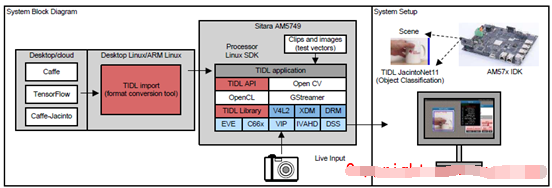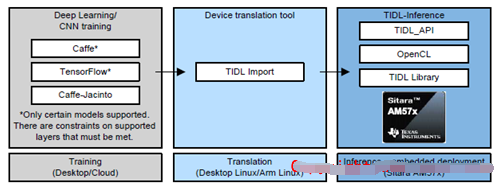TI IDEP-01004嵌入应用深度学习推理参考设计
 125
125
 拍明
拍明
原标题:TI IDEP-01004嵌入应用深度学习推理参考设计
TI公司的TIDEP-01004是嵌入应用深度学习推理的参考设计,基于Sitara AM57x系列系统级芯片(SoC).参考设计表明了如何在C66x DSP核(AM57x SoC)和嵌入视频引擎(VEV)子系统上运行深度学习推理.深度学习是一种机器学习,训练计算机实现人类任务如区分图像,识别语音或进行时间序列预测. 深度学习是人工智能(AI)的基础.它的模型是基于深层人工神经网络,也称作深度神经网(DNN).在DNN内,有许久不同的神经网络结构如卷积神经网络(CNN)和循环神经网络(RNN),能够解决不同类型问题.CNN模型在解决计算机可视问题很有希望,非常适合于图像分类,物体检测和语义分割.参考设计TIDEP-01004主要用在自动分类设备,光学检测,可视计算机,代码阅读器,工业机器人,物流机器人,钞票计数器,ATM,病人监护,建筑物自动化,工业交通,航天,航空电子和国防.中电网为您整理如下详细资料,本文介绍了参考设计TIDEP-01004主要特性,框图, TI深度学习(TIDL)开发流程图以及AM574x Sitara™处理器主要特性,框图, AM574x工业开发套件电路图和材料清单.
This reference design demonstrates how to use TIDeep Learning (TIDL) on a Sitara AM57x System-on-Chip (SoC) to bring deep learning inference to anembedded application. This design shows how to rundeep learning inference on either C66x DSP cores(available in all AM57x SoCs) and Embedded VisionEngine (EVE) subsystems, which are treated as blackboxed deep learning accelerators on the AM5749SoC.
This reference design is applicable to any applicationthat is looking to bring deep learning inference into anembedded application.
Customers looking to quickly get started with a deeplearning network or to evaluate their own networksperformance on an AM57x device will find a step-by-stepguide on how to use TIDL available as part of TI’sfree AM57x Processor SDK.
Deep learning is a type of machine learning that trains a computer to perform human-like tasks, such asidentifying images, recognizing speech, or making predictions in time series. Instead of organizing data torun through predefined equations, deep learning sets up basic parameters about the data and trains thecomputer to learn on its own by recognizing patterns using many layers of processing. Deep learning isone of the foundations of artificial intelligence (AI) and is influencing industry after industry by enablingproducts to behave intelligently like humans.
Deep learning models are based on deep artificial neural networks. They are also known as Deep NeuralNetworks (DNNs). Within DNNs, there are many different neural network architectures like ConvolutionNeural Networks (CNNs) and Recurrent Neural Networks (RNNs). These different architectures lendthemselves to solving different types of problems. CNN models are popular in solving computer visionproblems and are ideal for image classification, object detection and semantic segmentation.
At a high level, deep learning, similar to any automated system based on statistical machine learningtechniques, works as a two-stage process: Training and Inference. Training is the process of developing adeep learning algorithm. After training is completed, the networks are deployed into the field for“inference” — classifying data to “infer” a result. Training a deep learning model usually occurs offlineusing a large data set on servers or PCs with external accelerators such as graphics processing units(GPUs). Real-time performance or the thermal solution is not an issue during this phase. However, duringinference in an embedded system, real-time performance and device power consumption can be a keycare about for many end products.
TI addresses the need for bringing deep learning inference at the edge for embedded applications with thehighly integrated AM57x family of Sitara™ processors. The Sitara processors provide industrial gradesolutions with single to multicore Arm® processors, with the AM57x family equipped with high performanceArm Cortex®-A15 cores running at up to 1.5 GHz. The scalable family of AM57x provides dedicatedhardware for accelerated multimedia and industrial communication, multiple capture and display interfacesand a rich set of connectivity peripherals.
The AM57x family also features single and dual core C66x processors that are capable of running deeplearning inference as well as traditional machine vision algorithms. For additional inference performance,the AM5749 processor includes the addition of two EVE subsystems.
TIDL enables running the real-time inference part of deep learning at low power on both the C66x coresand the EVE subsystems. It is a set of open-source Linux software packages and tools that enablesoffloading of Deep Learning inference compute workloads from Arm cores to EVE subsystems and C66xcores. Developing and deploying CNN for image classification, object detection and pixel-level semanticsegmentation use cases on the AM5749 SoC is described in this document.
参考设计TIDEP-01004主要特性:
• Embedded deep learning inference on AM57x SoC
• Performance scalable TI deep learning library(TIDL library) on AM57x using C66x cores only,EVE subsystems only, or C66x + EVE combination.
• Performance optimized reference CNN models forobject classification, detection and pixel-levelsemantic segmentation.
• Full walk-through of TIDL development flow:training, import and deployment
• Benchmarks of several popular deep learningnetworks on AM5749
• This reference design is tested on AM5749 IDKEVM and includes TIDL library on C66x core andEVE subsystem, reference CNN models andGetting Started guide.
参考设计TIDEP-01004应用:
• Automated sorting equipment
• Optical inspection
• Vision computer
• Code readers
• Industrial robots
• Logistics robots
• Currency counters
• ATMs
• Patient monitors
• Building automation
• Industrial transport
• Space, avionics & defense

图1.参考设计TIDEP-01004外形图

图2.参考设计TIDEP-01004框图

图3.TIDL开发流程图
AM574x Sitara™处理器
AM574x Sitara™ processors are Arm® applications processors built to meet the intense processing needsof modern embedded products.
AM574x devices bring high processing performance through the maximum flexibility of a fully integratedmixed processor solution. The devices also combine programmable video processing with a highlyintegrated peripheral set. Cryptographic acceleration is available in every AM574x device.
Programmability is provided by dual-core Arm® Cortex®-A15 RISC CPUs with Neon™ extension, and twoTI C66x VLIW floating-point DSP cores, and two Embedded Vision Engines (EVEs). The Arm CPUs allowdevelopers to keep control functions separate from other algorithms programmed on the DSPs andcoprocessors, thus reducing the complexity of the system software.
Additionally, TI provides a complete set of development tools for the Arm® and C66x DSP, including Ccompilers, a DSP assembly optimizer to simplify programming and scheduling, and a debugging interfacefor visibility into source code execution.
Cryptographic acceleration is available in all devices. All other supported security features, includingsupport for secure boot, debug security and support for trusted execution environment are available onHigh-Security (HS) devices.
AM574x Sitara™处理器主要特性:
• Dual Arm® Cortex®-A15 microprocessor subsystem
• Up to two C66x floating-point VLIW DSP cores
– Fully object-code compatible with C67x andC64x+
– Up to thirty-two 16 × 16-bit fixed-point multipliesper cycle
• Up to 2.5MB of on-chip L3 RAM
• Two DDR3/DDR3L External Memory Interface(EMIF) modules
– Supports rates up to DDR3-1333
– Up to 2GB supported per EMIF
– ECC supported on primary EMIF
• 2× Dual Arm® Cortex®-M4 coprocessors (IPU1 andIPU2)
• Up to two Embedded Vision Engines (EVEs)
• IVA-HD subsystem
– 4K @ 15fps encode and decode support forH.264 CODEC
– Other CODECs are up to 1080p60
• Display subsystem
– Full-HD video (1920 × 1080p, 60 fps)
– Multiple video inputs and video outputs
– 2D and 3D graphics
– Display controller with DMA engine and up tothree pipelines
– HDMI™ encoder: HDMI 1.4a and DVI 1.0compliant
• 2× dual-core Programmable Real-Time Unit andIndustrial Communication Subsystem (PRU-ICSS)
• 2D-graphics accelerator (BB2D) subsystem
– Vivante® GC320 core
• Video Processing Engine (VPE)
• Dual-core PowerVR® SGX544 3D GPU
• Secure boot support
– Hardware-enforced root-of-trust
– Customer programmable keys and OTP data
– Support for takeover protection, IP protection,and anti-roll back protection
• Cryptographic acceleration support
– Supports cryptographic cores
– AES – 128/192/256-bits key sizes
– 3DES – 56/112/168-bits key sizes
– MD5, SHA1
– SHA2 – 224/256/384/512
– True random number generator
– DMA support
• Debug security
– Secure software controlled debug access
– Security aware debugging
• Trusted Execution Environment (TEE) support
– Arm TrustZone® based TEE
– Extensive firewall support for isolation
– Secure DMA path and interconnect
– Secure watchdog/timer/IPC
• Two Video Input Port (VIP) modules
– Support for up to eight multiplexed input ports
• General-Purpose Memory Controller (GPMC)
• Enhanced Direct Memory Access (EDMA)controller
• 2-port Gigabit Ethernet switch
• Sixteen 32-bit general-purpose timers
• 32-bit MPU watchdog timer
• Five Inter-Integrated Circuit ( I2C™) ports
• HDQ/ 1-Wire® interface
• Ten configurable UART/IrDA/CIR modules
• Four Multichannel Serial Peripheral Interfaces(McSPI)
• Quad Serial Peripheral Interface (QSPI)
• SATA Gen2 interface
• Eight Multichannel Audio Serial Port (McASP)modules
• SuperSpeed USB 3.0 dual-role device
• High Speed USB 2.0 dual-role device
• Four Multimedia Card/Secure Digital/ SecureDigital® Input Output Interfaces ( MMC™/
SD®/SDIO)
• PCI-Express® 3.0 ( PCIe®) subsystems with two 5-Gbps lanes
– One 2-lane Gen2-compliant port
– or two 1-lane Gen2-compliant ports
• Up to two Controller Area Network (DCAN)modules
– CAN 2.0B protocol
• Modular Controller Area Network (MCAN) module
– CAN 2.0B protocol with available FD(flexible data rate) functionality
• Up to 247 General-Purpose I/O (GPIO) pins
• Power, reset, and clock management
• On-chip debug with CTools technology
• 28-nm CMOS technology
• 23 mm × 23 mm, 0.8-mm pitch, 760-pin BGA(ABZ)
AM574x Sitara™处理器应用:
• Industrial communication
• Human Machine Interface (HMI)
• Automation and control
• High performance applications
• Analytics
• Other general use
AM574x Industrial Development Kit
责任编辑:David
【免责声明】
1、本文内容、数据、图表等来源于网络引用或其他公开资料,版权归属原作者、原发表出处。若版权所有方对本文的引用持有异议,请联系拍明芯城(marketing@iczoom.com),本方将及时处理。
2、本文的引用仅供读者交流学习使用,不涉及商业目的。
3、本文内容仅代表作者观点,拍明芯城不对内容的准确性、可靠性或完整性提供明示或暗示的保证。读者阅读本文后做出的决定或行为,是基于自主意愿和独立判断做出的,请读者明确相关结果。
4、如需转载本方拥有版权的文章,请联系拍明芯城(marketing@iczoom.com)注明“转载原因”。未经允许私自转载拍明芯城将保留追究其法律责任的权利。
拍明芯城拥有对此声明的最终解释权。




 产品分类
产品分类















 2012- 2022 拍明芯城ICZOOM.com 版权所有 客服热线:400-693-8369 (9:00-18:00)
2012- 2022 拍明芯城ICZOOM.com 版权所有 客服热线:400-693-8369 (9:00-18:00)


